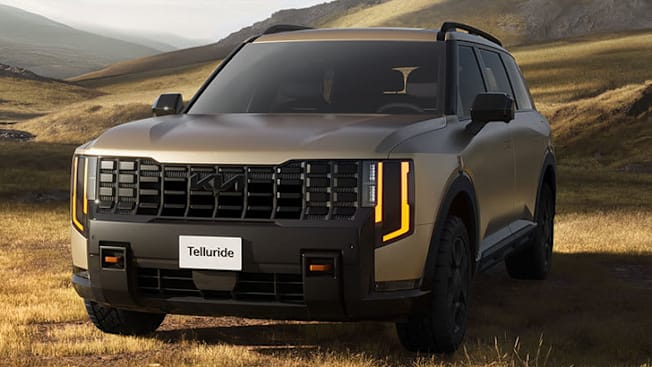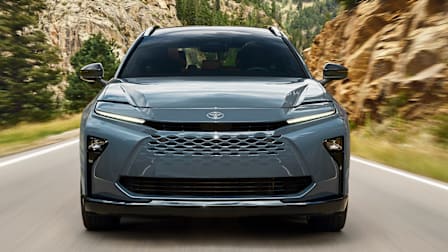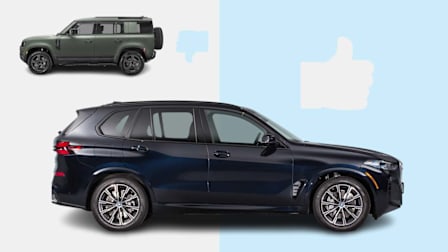Preview: 2027 Kia Telluride Grows, Gains Hybrid and Tech
A thorough redesign brings modern, upscale styling and abundant entertainment and safety features
The all-new 2027 Kia Telluride is poised to build on its award-winning predecessor, featuring a slightly increased size, a high-tech cabin, and numerous trim variants.
Details are still emerging, but based on the initial description and images, along with our extensive seat time in the related Hyundai Palisade, we have reason to be cautiously enthusiastic.
- 2027 Kia Telluride: CR's Take Outside Inside What Drives It Safety and Driver Assistance
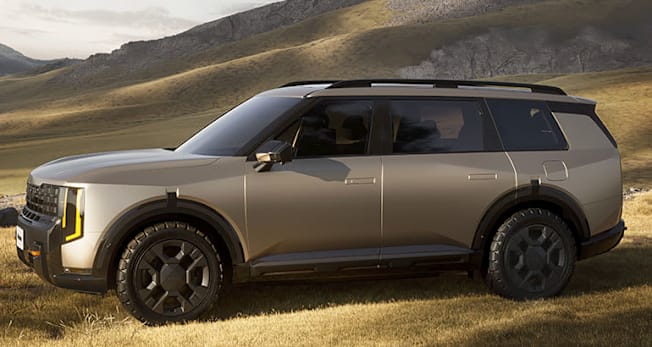
Photo: Kia Photo: Kia
CR's Take
The first-generation Telluride was a perennial Consumer Reports Top Pick and staff favorite. It entered a well-established segment, and promptly schooled older three-row, midsized SUVs on how to balance comfort, space, performance, and simplicity. It excelled in all areas that matter most to drivers, without requiring concessions. We hope the second-generation Telluride builds on that tradition.
We’ve experienced its corporate sibling, the redesigned Hyundai Palisade and Palisade Hybrid. Both versions have impressed us, providing a more luxurious alternative to humdrum mainstream SUVs. And despite their interior stylishness, we found the controls to be refreshingly logical. In general, the Palisade is free of many of the tragic flaws we’ve found in many other modern vehicles.
But the powertrains bring compromises that the previous Palisade and Telluride didn’t. We’ll learn more as the Telluride gets closer to production, at which point we’ll purchase one to fully test.
Read our Hyundai Palisade first drive.
Outside
The redesigned Telluride looks quite unlike the rather conventional outgoing model. The proportions are much different, with its 3-inch-longer wheelbase contributing to a longer look that reminds one of the Hyundai Santa Fe from the side. The body is quite smooth, with gentle curves offset by sparingly used crisp lines. The overall effect gives it a slightly computer-generated appearance in photos, an illusion supported by the retracted door handles—a change we don’t welcome.
The black plastic wheel arch trim has what looks like a pull tab at the top, a bewildering design accent we’re seeing on more models. It also adopts the “floating roof” styling that has proliferated throughout the industry in recent years, with black horizontal trim visually breaking up the rear pillar.
The vertical LED headlamps and taillights are quite distinctive. Both Hyundai and Kia have explored the design flexibility this now common technology enables with stunning variety. The downside is that there’s little brand identity to the lights beyond the fact that they’re often rather creative.
The Pro-X has a stark, blank face, with its large, black grille flanked by lights. It seems oddly unfinished in contrast to other, more refined exterior details. Black wheels and trim convey the off-road intentions of this trim, with the aggressive all-terrain tires declaring that the SUV is ready for adventure—and likely elevated road noise.
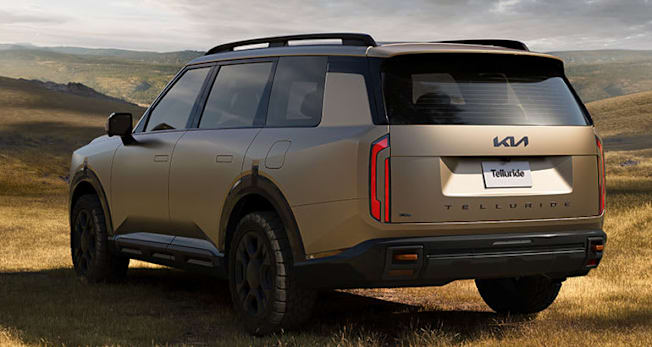
Photo: Kia Photo: Kia
Inside
Access is claimed to have been improved, thanks to the larger door openings afforded by the longer wheelbase. Once inside, passengers are given more room than before.
It’s expected that the interior will again be available in seven- and eight-passenger configurations, distinguished by the choice between captain’s chairs or a bench seat for the second row.
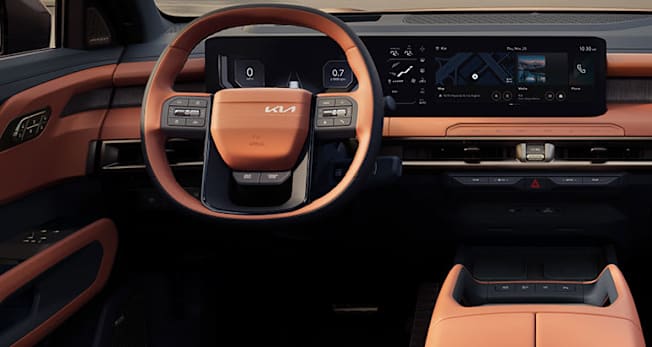
Photo: Kia Photo: Kia
The wide, horizontal display combines an available 12.3-inch instrument screen and 12.3-inch infotainment screen. Physical buttons are at a minimum, aside from those affixed to the steering wheel. Wireless Android Auto and Apple CarPlay are standard, as is an AI-powered voice assistant. A 14-speaker Meridian stereo system, including a subwoofer, is available.
There’s an available 12-inch head-up display, as well as a digital rearview mirror.
The cabin features upscale touches, like accent lighting, twin phone charging mats, and seating surfaces with embossed lines and various flourishes. The SXP has a head-up display, contrasting leather upholstery, powered second-row seats, and other comfort features.
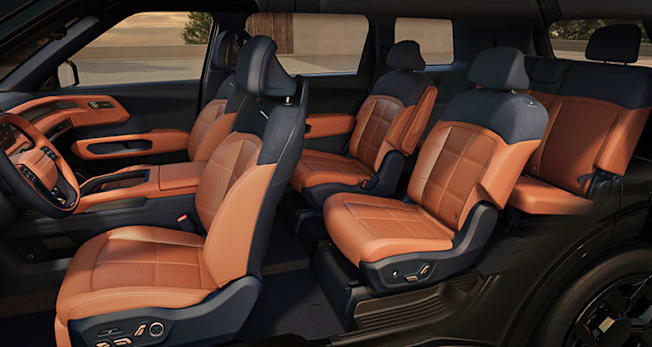
Photo: Kia Photo: Kia
What Drives It
The previous Telluride had a delightful 3.8-liter V6 that was glorious for its simplicity at a time when many rival models were moving to turbocharged four-cylinders in pursuit of fuel economy. Those smaller-displacement, force-fed engines tend to be noisier and feel more strained, even if their performance is technically the same or better than that of the six-cylinder they replaced.
We expected the Telluride to once again share powertrains with the Palisade. But this time, it moves to share its base engine with the Hyundai Sante Fe. That means a 274-hp, 2.5-liter turbocharged four-cylinder engine with an eight-speed automatic transmission as the standard configuration, with a choice of front- or all-wheel drive.
In the Santa Fe, our testers found that engine had what could be called “abundant verve.” And one road tester said: “It feels spirited out on the road, with plentiful low-end torque along with quick and direct shifts from the transmission. But the powertrain is marred by hesitation during rolling stops.”
Maximum tow capacity for the Telluride is 5,000 pounds, adequate for pulling a small travel trailer, boat, or other recreational vehicles.
Like the Palisade, the new Telluride is available with a 329-hp, 2.5-liter turbocharged four-cylinder hybrid engine with a six-speed automatic transmission. It’s offered in both front- and all-wheel drive. Notably, that means a 38-horsepower gain over the previous Telluride. Kia estimates fuel economy at up to 35 mpg.
Based on the first few hundred miles in the Palisade Hybrid we purchased for testing, the observed fuel economy is vastly improved over the previous V6 model. The window sticker proclaims an EPA-rated 29 mpg combined for our Hybrid Calligraphy. The front-wheel-drive Palisade Hybrid has an EPA-rated 31 mpg combined. But the trade-off is that the four-cylinder engine feels more stressed than the V6.
We’ll thoroughly evaluate the powertrain when we buy a Telluride to test.
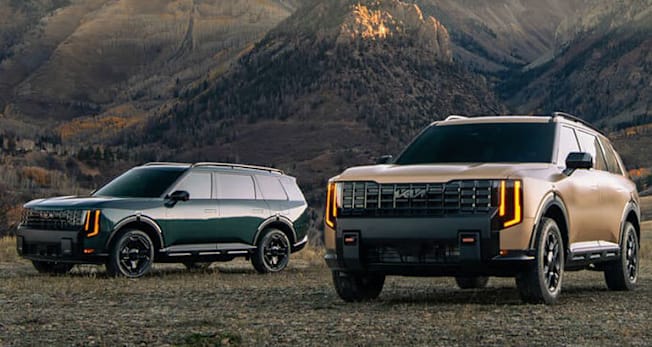
Photo: Kia Photo: Kia
Safety and Driver Assistance
The Telluride features the brand’s latest bundle of active safety and driver assistance systems, including automatic emergency braking, blind spot warning, and rear cross traffic warning. Other available features include adaptive cruise control, lane centering assistance, driver attention monitoring, and safe exit, which prevents passengers from opening a door in the path of oncoming traffic when parked.
The Telluride comes with a rear occupant alert system that uses radar to scan for children when the vehicle is parked and locked. If it detects movement, the SUV will honk the horn and send an alert to the driver’s phone. Such a system adds valuable protection to reduce the risk of an unaccompanied child gaining access to the vehicle or being left behind.
A video rearview mirror is available that uses a liftgate-mounted camera to give an unobstructed view behind the SUV. We’ve found that this feature is most appreciated when the vehicle is loaded with passengers and cargo.
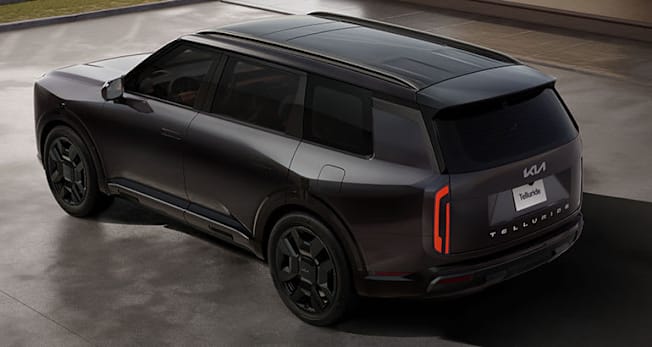
Photo: Kia Photo: Kia

















